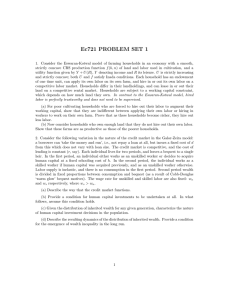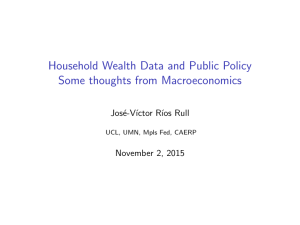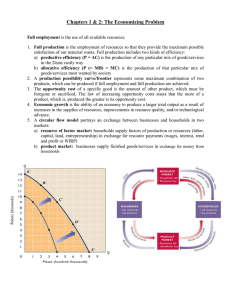The analysis of Households’ wealth with and beyond national accounts
advertisement
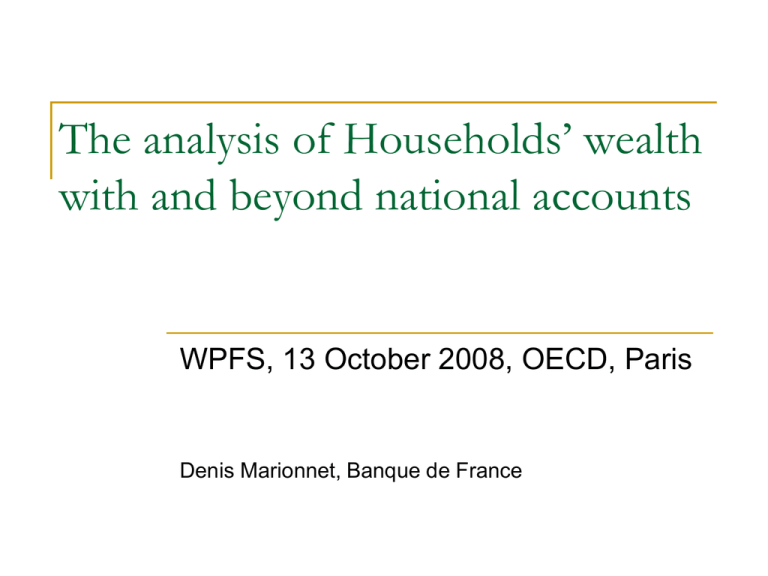
The analysis of Households’ wealth with and beyond national accounts WPFS, 13 October 2008, OECD, Paris Denis Marionnet, Banque de France Introduction (1/3) The most common use of national accounts to analyse HHs’ wealth consists in combining: data from financial accounts: outstanding amounts financial transactions revaluation flows (when available) and/or data from total wealth accounts: land housing These data allows analysing: the evolution in time of the structure of total portfolio or financial portfolio (stocks), financial transactions and arbitrages between financial instruments, growth rates of different assets, indices on outstandings,… international comparisons,… With various tables and graphs The analysis of households' wealth with and beyond national accounts, OECD,WPFS 13 October 2008 2 Introduction (2/) Examples taken from the Banque de France Bulletin Digest No 148, April 2006: http://www.banque-france.fr/gb/publications/telechar/bulletin/148etud1.pdf The analysis of households' wealth with and beyond national accounts, OECD,WPFS 13 October 2008 3 Introduction (2/2) Examples taken from the ECB Monthly Bulletin, November 2007 http://www.ecb.int/pub/pdf/other/pp75-87_mb200711en.pdf The analysis of households' wealth with and beyond national accounts, OECD,WPFS 13 October 2008 4 Overview Brief presentation of 4 papers that propose ways to supplement the traditional analysis of HHs’ wealth: 1. Enhancing the analysis by combining micro data from Wealth Surveys with national accounts 2. Enhancing the analysis by making financial intermediation transparent “The composition of household wealth between 1997 and 2003”, P. Girardot and D. Marionnet, Quarterly Selection of Articles of the Banque de France, n°12, Summer 2008 “La destination finale de l’épargne des ménages”, A. Rincon, Bulletin de la Banque de France, n°167, November 2007 “The final financial investment of French households”, D. Marionnet, Irving Fisher Committee Bulletin, n°25, Bank for International Settlements, March 2007 3. Enhancing the analysis by taking into account implicit social security and pension wealth in HHs’ assets “Implicit social security and pension wealth in households’ assets in the US and France”, D. Durant and M. Reinsdorf, paper presented at the International Association for Research in Income and Wealth, August 2008 The analysis of households' wealth with and beyond national accounts, OECD,WPFS 13 October 2008 5 1. National accounts data combined with Wealth Surveys The idea was to combine in the same article : National financial and non-financial accounts data drawn up by INSEE and the Banque de France With a particular look at valuation effects on both real estate and financial assets Households’ Wealth Surveys data conducted by French NSI, INSEE, in 1998 and 2004, adjusted against these macroeconomic data This Survey looks at the changes in the distribution of household wealth (real-estate, financial and professional) and the holding rates of the various assets. It also includes very detailed information on the factors underlying households’ investment behaviour: family and professional biographies, inheritance and donations, income and financial position, motives for holding/ not holding a certain type of asset. The article: “The composition of household wealth between 1997 and 2003”, P. Girardot and D. Marionnet, Quarterly Selection of Articles of the Banque de France, n°12, Summer 2008 (http://www.banque-france.fr/gb/publications/telechar/bulletin/qsa/qsa12etud_6.pdf) The analysis of households' wealth with and beyond national accounts, OECD,WPFS 13 October 2008 6 1. National accounts data combined with Wealth Surveys Methodological aspects: In order to bring the scope of the financial accounts in line with that of the INSEE Wealth Survey, some assets hardly held by households were not included in the analysis. In addition, for comparison purposes, financial assets were grouped together at the macroeconomic level in a different manner than in the usual presentation of financial accounts. Because the survey data tend to underestimate outstanding amounts relative to national accounting data, the results presented in this article are based on the amounts adjusted against wealth outstanding amounts in the national accounts . The analysis of households' wealth with and beyond national accounts, OECD,WPFS 13 October 2008 7 1. National accounts data combined with Wealth Surveys Between 1997 and 2003, gross household wealth increased rapidly (average annual increase of 8.6% compared to 4.1% for their gross disposable income) Mainly as a result of a boom in realestate prices Real estate accounted for 58% of households’ private wealth (excl. professional wealth) in 1997, compared with 66% in 2003. Contributions to the increase of total wealth: rise in real estate assets : 78% of which increase in the value of housing and land : 61% of which increase in investment flows: 17% increase in households’ financial assets: 22% of which cumulated annual investment flows: 21%) of which increase in the value of financial assets: 1% The analysis of households' wealth with and beyond national accounts, OECD,WPFS 13 October 2008 8 1. National accounts data combined with Wealth Surveys Illustration The analysis of households' wealth with and beyond national accounts, OECD,WPFS 13 October 2008 9 1. National accounts data combined with Wealth Surveys Wealth inequalities increased between 1997 and 2003: The Gini index (concentration indicator calculated on the basis of private wealth) rose from 0.614 in 1997 to 0.629 in 2003. Thus, the private assets held by the 10% least wealthy households amounted to less than EUR 2,110 in 2003, compared with EUR 1,930 in 1997, whereas those held by the 10% wealthiest households stood at over EUR 450,060 in 2003, as against EUR 296,400 in 1997. Homeowners posted a very significant rise in their gross private wealth, while on average households holding only financial assets have benefited less. The analysis of households' wealth with and beyond national accounts, OECD,WPFS 13 October 2008 10 1. National accounts data combined with Wealth Surveys Illustration: detailed tables presenting HHs’ total, real estate or financial wealth broken down according to households’ characteristics The analysis of households' wealth with and beyond national accounts, OECD,WPFS 13 October 2008 11 1. National accounts data combined with Wealth Surveys % The analysis of households' wealth with and beyond national accounts, OECD,WPFS 13 October 2008 12 1. National accounts data combined with Wealth Surveys Five types of more or less diversified financial portfolios drawn up using a hierarchical ascending classification method: The analysis of households' wealth with and beyond national accounts, OECD,WPFS 13 October 2008 13 1. National accounts data combined with Wealth Surveys This typology can be linked to the structure of private wealth by decile as households are more likely to diversify their portfolio when their personal environment is favourable: stable family situation, high income, no risk of unemployment. The analysis of households' wealth with and beyond national accounts, OECD,WPFS 13 October 2008 14 1. National accounts data combined with Wealth Surveys Risky financial assets: higher holding rates in 2003 than in 1997 HHs’ financial savings increasingly channelled into risky investments: the share of their risky assets rose from 14.0% in 1997 to 19.2% in 2003, after having peaked at 23.8% in 2000. In a context characterised by large fluctuations in financial market prices, it is useful to define the characteristics of holders of risky financial assets and to attempt to explain their behaviour using an “all other things being equal” analysis. The qualitative model used measures the impact of each household characteristic (age, socio-occupational category, type of household, whether the parents were holders of risky assets, income, etc.) on the probability of holding a risky financial asset. What is measured is the gap between the probability of holding a risky financial asset in the reference situation and in the situation under review. The reference situation is that of households between 40 and 49, in an intermediate-grade occupation in the public sector, with two children and in the 5th decile of private wealth and disposable income. Main findings: The head of the typical household holding risky assets has a high income and considerable wealth. His parents also held risky assets; he has no children. Similar considerations seem to prevail among managers: in 2003, they hold risky assets slightly more often than the other social categories. In general, households’ investment behaviour is carried over from one generation to the next. Overall, households’ wealth, level of income and degree of information on financial investments are key determinants of their propensity to hold risky assets. The analysis of households' wealth with and beyond national accounts, OECD,WPFS 13 October 2008 15 2. Making financial intermediation transparent As the proportion of intermediated instruments in HHs’ financial wealth increases in many countries, the interest in X-raying their financial investment gets increasingly relevant. Using a method that makes financial intermediation transparent is one way of doing so, making possible to complement the use of financial accounts for the analysis of HHs’ financial wealth. Indeed, SNA93 and ESA95 nomenclatures do not always provide sufficient detail for a complete analysis of HHs’ wealth and the risks they bear. This method was first used by M. Boutillier et al. in “Placements des ménages en Europe : le rôle des intermédiaires financiers se transforme en profondeur”, Economie et Statistiques, n°354, pp. 85-102, 2002. The analysis of households' wealth with and beyond national accounts, OECD,WPFS 13 October 2008 16 2. Making financial intermediation transparent This approach consists in “looking through” financial institutions (FI) and reallocating to households the “final” assets that FI hold on other sectors: Available, if possible, with different breakdowns in order to enhance the analysis: deposits, debt securities, quoted shares, unquoted equity, less or equal to 1 year / over 1 year maturity, national currency / foreign currencies, resident counterparties / non-resident counterparties, securities issued by general government / issued by other sectors, etc,… For the re-allocation process, the structure of investment of each FI is applied to households’ assets held with FI. As FI also invest part of their assets with other FI, this method has to be applied several times so as to completely eliminate intermediated investments from the structure applied to HHs intermediated assets. Indeed, life insurance corporations invest in mutual fund shares and mutual funds are allowed to invest into other mutual fund shares. Therefore, after one round of ‘re-allocation’, mutual fund shares remain in HHs’ assets. Thus, the remaining amount of investment in MFS should be replaced by the structure of their investment, giving again a residual amount invested in MFS,... This can be solved by matrix stepwise calculations: please refer to the articles The analysis of households' wealth with and beyond national accounts, OECD,WPFS 13 October 2008 17 2.1 Making transparent financial assets held with all FI in 2006 In this case, 4 ‘final’ instruments: Available with the following breakdowns: deposits (including loans and currency), debt securities, quoted shares, unquoted equity (AF512+AF513), national currency / foreign currencies, resident counterparties / non-resident counterparties, General Government financing / private sector financing, For the year 2006 Financial intermediaries made transparent: Credit institutions and investment corporations (~ banks) Money market mutual funds Non-money market mutual funds Insurance Corporations The article: “La destination finale de l’épargne des ménages”, A. Rincon, Bulletin de la Banque de France, n°167, November 2007 (http://www.banquefrance.fr/fr/publications/telechar/bulletin/etu167_2.pdf) The analysis of households' wealth with and beyond national accounts, OECD,WPFS 13 October 2008 18 2.1 Making transparent financial assets held with all FI in 2006 The initial structure of HHs’ financial investment (1) At end 2006, 87% of HHs’ financial assets were placed with financial intermediaries and 13% were directly invested in final assets The analysis of households' wealth with and beyond national accounts, OECD,WPFS 13 October 2008 19 2.1 Making transparent financial assets held with all FI in 2006 Financial intermediaries’ structure of investment (1) Each FI has its own structure of investment: The analysis of households' wealth with and beyond national accounts, OECD,WPFS 13 October 2008 20 2.1 Making transparent financial assets held with all FI in 2006 The final destination of HHs’ savings A different view of HHs’ financial investment : The transparency making process modifies significantly the structure of investment by instrument of HHs’ financial wealth The analysis of households' wealth with and beyond national accounts, OECD,WPFS 13 October 2008 21 2.1 Making transparent financial assets held with all FI in 2006 The final destination of HHs’ savings Financial intermediation contributes to international diversification of HHs’ financial investment: The analysis of households' wealth with and beyond national accounts, OECD,WPFS 13 October 2008 22 2.1 Making transparent financial assets held with all FI in 2006 The final destination of HHs’ savings Financial intermediation contributes to international diversification of HHs’ financial investment: The analysis of households' wealth with and beyond national accounts, OECD,WPFS 13 October 2008 23 2.1 Making transparent financial assets held with all FI in 2006 The final destination of HHs’ savings HHs’ financial investment after transparency making process largely finances General Government, French or Euro area: The analysis of households' wealth with and beyond national accounts, OECD,WPFS 13 October 2008 24 2.1 Making transparent financial assets held with all FI in 2006 The final destination of HHs’ savings HHs’ financial investment after transparency making process largely finances General Government, French or Euro area: The analysis of households' wealth with and beyond national accounts, OECD,WPFS 13 October 2008 25 2.2 Making transparent financial assets held with all nonbanking FI during 1994-2005 In this case, 5 ‘final’ instruments: Available with the following breakdowns: deposits (including loans and currency), debt securities, quoted shares, unquoted equity (AF512+AF513), and additional real-estate related financial instruments. less or equal to 1 year / over 1 year maturity, national currency / foreign currencies, resident counterparties / non-resident counterparties. Over the period 1994-2005 The article: “The final financial investment of French households”, D. Marionnet, Irving Fisher Committee Bulletin, n°25, Bank for International Settlements, March 2007 (http://www.bis.org/ifc/publ/ifcb25o.pdf) The analysis of households' wealth with and beyond national accounts, OECD,WPFS 13 October 2008 26 2.2 Making transparent financial assets held with all nonbanking FI during 1994-2005 Initial structure of HHs' financial investments 100% 80% 60% 40% 20% 0% Dec- Dec94 95 Dec- Dec- Dec96 97 98 Dec- Dec99 00 Dec- Dec- Dec01 02 03 Life insurance (F611) Mutual fund shares (F52) Unquoted equity (F512+F513) Quoted shares (F511) Debt securities (F3) Deposits, loans and currency (F2+F4) Source: Banque de France (quarterly financial accounts) Dec- Dec04 05 Deposits, loans and currency: predominant but declining (from 45% to 35%) Life insurance: the most rapid and constant growth (from 19.9% to 34.4%) Unquoted equity: significant increase (from 12.3% to 19.6%) Mutual fund shares: significant decrease in MMFs’ shares (5.7% to 1%), slighter decrease of other MFs’ shares (from 11.1% to 8.7%) Quoted shares: some fluctuations around 4% Debt securities: sharp decrease in direct holding (from 6.4% to 1.5%) The analysis of households' wealth with and beyond national accounts, OECD,WPFS 13 October 2008 27 2.2 Making transparent financial assets held with all nonbanking FI during 1994-2005 Compared to direct holding, debt securities is the ‘final’ instrument which increases the most, followed by quoted shares while unquoted equity and deposits present a limited increase. HHs' financial investments in ‘final’ instruments 100% 80% 60% 40% 20% 0% Dec- Dec- Dec- Dec- Dec- Dec- Dec- Dec- Dec- Dec- Dec- Dec05 04 03 02 01 00 99 98 97 96 95 94 Deposits, loans and currency (F2+F4) Quoted shares (F511) Real-estate related financial instruments Debt securities (F3) Unquoted equity (F512+F513) Deposits, loans and currency: still predominant despite a decline (from 49% to 38%) Debt securities: fluctuations around 30% Unquoted equity: increasing though in spite of some fluctuations due to market valuation Quoted shares: fluctuations due to stock market prices evolution Additional real-estate related assets: residual Source: Banque de France (quarterly financial accounts and IFs database) The analysis of households' wealth with and beyond national accounts, OECD,WPFS 13 October 2008 28 2.2 Making transparent financial assets held with all non-banking FI during 1994-2005 Direct and intermediated HHs’ holdings of Debt securities Quoted shares 100% 100% 80% 80% 60% 60% 40% 40% 20% 20% 0% 0% Dec- Dec- Dec- Dec- Dec- Dec- Dec- Dec- Dec- Dec- Dec- Dec94 95 96 97 98 99 00 01 02 03 04 05 Direct holding Via Mutual fund shares Via Life insurance (in % of all final holdings of the instrument) At Dec05, 78% of HHs’ final investment in debt securities are made via life insurance, 17% via mutual funds and 5% directly. Dec- Dec- Dec- Dec- Dec- Dec- Dec- Dec- Dec- Dec- Dec- Dec94 95 96 97 98 99 00 01 02 03 04 05 Direct holding Via Mutual fund shares Via Life insurance (in % of all final holdings of the instrument) Quoted shares, as a ‘final’ instrument, are held in a fairly even manner over the period. At Dec05, 42% are held via ICs, 30% directly and 28% via IFs. Unquoted equities are in average held directly at more than 85% over the decade The analysis of households' wealth with and beyond national accounts, OECD,WPFS 13 October 2008 29 2.2 Making transparent financial assets held with all nonbanking FI during 1994-2005 Chart 7: Share of risky assets in HHs' financial wealth 40% 35% 30% 25% 20% 15% 10% Dec94 Dec95 Dec96 Dec97 Dec98 Dec99 Dec00 Dec01 Dec02 Dec03 Dec04 Dec05 risky assets = assets highly sensitive to price fluctuations French HHs tend to increasingly hold risky assets: clear upward trend (in spite of sensitivity to stock market fluctuations). After transparency Chart 8: Share of risky assets in HHs' financial and non financial wealth 78% 76% 74% 72% 70% 68% 66% 64% Dec94 Dec95 Dec96 Dec97 Dec98 Dec99 Dec00 Dec01 Dec02 Dec03 Dec04 Dec05 Risky assets predominant (77%) when housing assets are included. The trend towards more risk exposure has been reinforced by the rapid rise in housing prices since 2000. in total w ealth The analysis of households' wealth with and beyond national accounts, OECD,WPFS 13 October 2008 30 2.2 Making transparent financial assets held with all nonbanking FI during 1994-2005 Chart 10: Share of liquid assets in households' financial wealth 80% 70% 60% 50% 40% 30% 20% 10% 0% Dec94 Dec95 Dec96 Dec97 Dec98 Before transparency Dec99 Dec00 Dec01 Dec02 Dec03 Dec04 Dec05 After transparency Liquidity = ability to sell relatively rapidly the underlying instruments to obtain cash. HHs’ financial asset is less liquid than that of IFs and life ICs. Indeed, life ICs invest in marketable securities whereas HHs’ assets in life insurance may not be considered as liquid products (tax-exemption on realised capital-gains occurs after 8 years). A different picture would appear if MFIs were made transparent as they hold an important share of non-liquid assets (loans mainly) on their asset side. The analysis of households' wealth with and beyond national accounts, OECD,WPFS 13 October 2008 31 2.2 Making transparent financial assets held with all non-banking FI during 19942005 Chart 11: Share of HHs' financial assets invested in foreign currencies 6% 5% 4% 3% 2% 1% 0% Dec94 Dec95 Dec96 Dec97 Dec98 Dec99 Dec00 Dec01 Dec02 Dec03 Dec04 Dec05 After transparency French financial accounts do not distinguish euro-denominated assets from foreign currency denominated assets for the instruments ‘other mutual fund shares’ and ‘life insurance contracts’. => currency risk exposure can only be calculated after transparency. The share of assets denominated in foreign currencies after transparency lies a little bit above 5% before the euro changeover and around 4.5% after. => the euro changeover permitted geographical diversification while reducing the need to bear currency risk. French HHs bear a low and relatively stable foreign currency risk. The analysis of households' wealth with and beyond national accounts, OECD,WPFS 13 October 2008 32 2.2 Making transparent financial assets held with all non-banking FI during 19942005 Chart 12: Share of HHs' financial assets invested with NR counterparts 25% 20% 15% 10% 5% 0% Dec94 Dec95 Dec96 Dec97 Dec98 Before transparency Dec99 Dec00 Dec01 Dec02 Dec03 Dec04 Dec05 After transparency Before transparency, the share of HHs’ wealth invested in assets involving NR counterparts is quite low reflecting the fact that HHs primarily transact with resident intermediaries and do not easily invest directly with RoW counterparts. After transparency, geographical diversification comes from financial intermediaries and is increasing. The share of HHs’ wealth involving NR issuers or counterparts started to rise in 1998, climbing from 11.5% up to 21.9% in Dec. 2005. This increase has been made possible by the euro, which allows geographical diversification without currency risk (ICs are constrained by regulatory rules in their capacity to incur such a risk). The analysis of households' wealth with and beyond national accounts, OECD,WPFS 13 October 2008 33 3. Enlarging households’ wealth for pensions (1/5) Households’ pension wealth in social security and ICPF in the supplementary tables of the revised SNA: a test exercise for France Data available for pension entitlements and related flows for 2005 data in bold are calculated from published data, others are estimates of the authors civil servants plan social security from Prost DC plans & ife insurance DB plans & book reserves contributors 2 635 1 586 2 459 16 638 19 097 22 058 beneficiaries 2 635 ? 1 961 11 939 13 900 11 994 70 87 950 6 565 7 672 5 980 4 4 24 136 167 139 11 11 13 social security total 1 Pension entitlement (opening BS) 2 actual contributions 3 taxes and govt transfers 4 imputed contributions incl. actualisation 1 6 34 319 360 281 5 pensions paid 2 2 33 160 197 153 6 Pension entitlement (closing BS) 74 94 975 6 872 8 015 6 260 6 = 1+2+3+4-5 discount rate = 2% contributors of column 3 and 4 add up to the total, but not the one for columne 1 and 2 as these plans are supplementaries The analysis of households' wealth with and beyond national accounts, OECD,WPFS 13 October 2008 34 3. Enlarging households wealth for pensions (2/5) Insurance corporations (mainly) and PERCO (marginally) are in charge of private pension plans in France Private pensions, data sources and estimation methods outstanding amounts as at en 2006, in euro million nature classification in the present study life insurance and other DC plans insurance contracts with fiscal provisions defined contribution (art 82 CGI) defined contribution (art 83 CGI) individual workers (Madelin) pension in life farm worker insurance specialised insurance corporations Institution de prévoyance Institutions de retraite supplémentaire Mutual insurance individual pension plans life insurance PERP other individual plans pension in specialised financial corporation pension funds PERCO pension in DB plans and book reserves employer sector defined benefit (art 39 CGI) (risk born by the retirement benefit employer) companies net liabilities sources FFSA FFSA FFSA FFSA type status in fin. accounts reserves contributions pensions dc dc dc dc estimates estimates estimates life insurance reserves 2 734 20 933 11 154 2 214 190 1 899 1 705 205 160 1 224 188 37 life insurance reserves 4 000 19 600 15 000 ? ? ? 17 83 63 2 350 29 041 852 3 520 0 893 761 432 0 30 993 11 901 25 674 2 797 1 275 ? 1 812 696 ? FFSA FFSA dc dc life insurance reserves AFG dc mutual funds shares FFSA FFSA Mercer db db ? life insurance reserves not yet recorded The analysis of households' wealth with and beyond national accounts, OECD,WPFS 13 October 2008 35 3. Enlarging households wealth for pensions (3/5) Compilation of actuarial value of pension funds in the US Table A.3: Balance Sheet for US Households with Actuarial Measures of Pension and Social Security Wealth (Ratios to Net Disposable Household Income; Unincorporated Businesses Consolidated) Real estate and tangible assets of unincorporated businesses Deposits and money market shares Bonds and mortgages, including held in mutual funds, plus miscellaneous Equities (directly held+held in mutual funds) Life insurance, annuities and defined contribution pension and retirement plans Actuarial value of defined benefit pension plans Actuarial value of benefits payable by the Pension Benefit Guarantee Corp Actuarial value of future social security benefits net of future taxes Home mortgage debt Other liabilities Assets of social security trust fund Social security trust fund+taxes less benefits for future participants if positive Financial net worth with actuarial values of pension wealth 2006 2.99 0.77 2007 2.92 0.80 0.77 0.92 0.83 0.84 0.74 0.85 0.74 NA 0.007 1.71 1.08 0.72 0.20 0.007 1.71 1.09 0.75 0.20 0.20 2.24 0.28 NA The analysis of households' wealth with and beyond national accounts, OECD,WPFS 13 October 2008 36 3. Enlarging households wealth for pensions (4/5) A renewed view on international comparison of households assets (in% of corrected disposable income – social security by Prost) United states France 10 7 7 8 8 6 6 5 5 6 6 4 4 4 4 3 3 2 2 2 2 0 0 1 1 0 0 20 20 20 20 19 19 19 20 07 20 06 20 05 20 04 20 03 20 02 20 01 20 00 19 99 19 98 19 96 19 95 19 97 social security db pension plans Life insurance and dc pension plans Equities, including held in mutual funds Bonds, incl. held in mutual funds, miscellaneous Deposits and money market shares Residential real estate and fixed assets All mortgate and nonmortgage liabilities Residential mortgage liabilities 07 10 05 8 03 8 01 12 99 12 97 9 95 9 social security defined benefit plans and boo k reserves life insurance and other defined contribution plans equities including held in mutual funds bonds and bills, including held in mutual funds deposits (incl. held in mutual funds) and MMF housing other net assets o.w. mortgage debt loans from credit institutions The analysis of households' wealth with and beyond national accounts, OECD,WPFS 13 October 2008 37 3. Enlarging households wealth for pensions (5/5) The risk on social security may be measured by the discounted future financing gaps Assets and “value at risk” (in grey) for HHs in France (as a % of gross disposable income) The article: “Implicit social security and pension wealth in households” assets in the US and France”, D. Durant and M. Reinsdorf, paper presented at the International Association for Research in Income and Wealth, August 2008 (http://www.iariw.org/papers/2008/durant.pdf) The analysis of households' wealth with and beyond national accounts, OECD,WPFS 13 October 2008 38
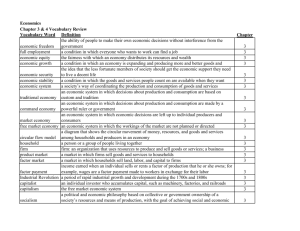
![-----Original Message----- [mailto:] Sent: Saturday, March 19, 2005 12:55 AM](http://s2.studylib.net/store/data/015586592_1-9284065775c2c8448f23d0ece525b0be-300x300.png)



